Arrive in Lome where our representative will be expecting you to transfer you to your hotel.



TOGO Lomé, the vibrant capital of Togo, is the only African city that was a colony of the Germans, British, and French. It is also one of the few capitals in the world bordering another nation. These elements have led to the development of a unique identity reflected in the lifestyle of its inhabitants and in the architecture of the town: Lomé is indeed a cross point for people, trade, and cultures, a small cosmopolitan city.
We will visit: the central market with its famous “Nana Benz”, women who control the market of the expensive “pagne” (fabrics) coming from Europe and sold all over West Africa, and the colonial buildings of the administrative quarter where the reminiscent of colonial time is still present.
We will stop at the fetish market where a huge and eclectic assortment of all the necessary ingredients for love potions and magical concoctions can be found.
In a remote village, we will join a Voodoo ceremony: the frenetic rhythm of the drums and the chants of the adepts call in the voodoo spirits who then take possession of some of the dancers. They fall into a deep trance: eyes rolling back, grimaces, convulsions, insensitivity to fire or pain. Sakpata, Heviesso, and Mami Water are just some of the voodoo divinities that can manifest. In this narrow village, surrounded by the magic atmosphere of the ceremony, we will finally understand what people mean when they say: “In your Churches, you pray to God; in our voodoo shrines, we become Gods! “
100km - 3 hours travel time from Lome to Agbodrafo



Voodoo Ceremony
Market visits
TOGO & BENIN Benin border crossing (Hilla Kodji / Save Kodji). Drive to Ouidah. Ouidah was conquered by the Dahomey Kingdom during the 18th century to become one of the main slave ports. Today Ouidah enjoys Afro-Brazilian architecture with the python temple facing the Catholic Cathedral. The laid-back attitude of the locals blends in harmoniously with the thunder of the distant waves and the rhythm of the drums – a timeless atmosphere well described by Bruce Chatwin in his book “The Vice-Roy of Ouidah”. By foot, we visit the Python Temple and the Portuguese Fort, now a small but interesting museum on the history of Ouidah.
We end the visit following the “slave road” to the beach, the point of no return where the slaves were shipped to the New World.
from Agbodrafo to Ouidah (70 km – travel time: 2h)



Cross into Benin, Phyton Temple and Portuguese Fort
We cross Lake Nokwe with a motorized boat to reach Ganvié, the largest and most beautiful African village on stilts. The approximately 25,000 inhabitants of the Tofinou ethnic group build their wooden huts on teak stilts. Fishing is their main activity. Ganvié has managed to preserve its traditions and environment despite the long-lasting human presence in a closed setting. The lake is not over-fished and fishing habits and rules of the past are still in use. Daily life unfolds in the dugout canoes that adults and children row easily using brightly colored paddles. Aboard these canoes men fish, women expose goods at the floating market, and children go to school and play.
Once returned to the mainland we drive to Abomey. Meeting with the community of “forgerons,” who have served Dahomey kings for centuries in the production of weapons and other tools. We attend a dancing masks.
.from Ouidah to Dassa (280 km – travel time: 5 h)



Village on Stilts
Today is a long but intense day. The first stop will be at Dankoli Fetish, an important place of voodoo worship, today still practiced. Thousands of short sticks are pushed in and all around the fetish testifying to the huge number of prayers addressed to the local god to satisfy everyday needs: a good harvest, a happy wedding, a problem-free birth, success at school, etc. Once the prayers are answered, people come back to sacrifice what they had promised to the god: a chicken, a cow, or a goat. Fresh traces of blood, palm wine, and palm oil on the fetish prove that many prayers and requests have been fulfilled.
In the afternoon we discover a few old Taneka villages located on the slopes of the mountains of the same name. These villages are made up of round huts covered with a conical roof protected on the top by a terracotta pot. The upper part of the village is inhabited by the young initiated and by the fetish priests who only cover themselves with the skin of a goat and always carry a long pipe. It seems that the first inhabitants, of Kabyé origin, occupied the mountain in the 9th century AD. Since then, other ethnic groups have joined thus forming a kind of melting pot where even though each group has preserved its own cults and initiation rites, at the same time common political and religious institutions have been created.
While walking around the villages, among houses with conical roofs, along narrow streets bordered by smooth stones, it happens to meet young people and adults half-naked and with shaved heads. They prepare for the initiation celebrations. The Tanekas believe that in order to “become” a man, it is necessary to combine time, patience, and many sacrifices. In short, a process that spans an entire existence, to the point that life itself becomes a rite of passage.
During the Yam Festival Journey we participate in this festival. From libations on new crops to festive lunch and final dances in the afternoon.
Dassa to Natitingou (350 km – travel time: 8 h)


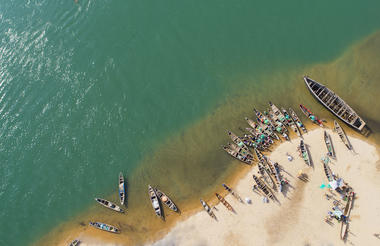
Fetish Hills and Taneka Villages
Today we enter the land of the Somba and Tamberma. In this landscape of smooth hills and plateaus, we meet the Tamberma and the Somba who live in fortified houses. Similar in shape to our medieval castles, these houses represent one of the finest examples of ancient African architecture. Their style impressed Le Corbusier, who called them “sculptural architecture”. In fact, the houses are built by hand, layer after layer of clay, adding mud balls which are then modeled on the plan of the house in a kind of sensual gesture mixing strength, care, and beauty.
The attachment to their traditions is demonstrated by the presence of large phallic-shaped shrines placed at the entrance of the houses. With the permission granted to us by the elders, we enter the houses to better understand their way of life. Actually, the houses are projections of their cosmology: the ground floor, with its darkness, represents death and is the place of the ancestors; the second floor, open to the sky, represents life and it is the place where grandmothers look after the little ones, up to when it is identified which ancestor has returned to live in the newborn. All food and animals are kept inside the fortified houses, for safety reasons in case of attack by enemies. For centuries these populations have been seeking refuge in the Atakora Mountains to escape Muslim slave traders coming from the north.
Natitingou to Kara(100 km – travel time: 3 h)
Adobe Castles of Somba and Tamberma
Today we meet the Kabyes: in some villages, on top of the hills, women mold clay pots, and men work iron giving it shape with fire and heavy stones.
In the evening, we attend the fire dance: in the center of the village, a large fire illuminates the faces of the people who dance to the hypnotic rhythm of the drums before diving into the burning embers. They collect incandescent embers and pass them several times over the body as well as bring them to the mouth as if they had to swallow them, no wounds and no signs of pain appear on the faces of the dancers. Is it about courage? Self-suggestion? Magic?Difficult to explain such a performance.
Maybe it’s really their fetishes that protect them from the fire.
Defale to Sokode (100 km – travel time: 3 h)



The Dance of Fire
We will head southwards, with a stop on the way in Atakpame, a typical African small town built on hills where all the products coming from the nearby forests can be found. Through their skilled work on small weaving looms, men of the region make the large brightly coloured fabric called “Kente”.
From Atakpame we move to the tropical forests surrounding Kpalime, a town with a rich colonial past which is now an important cocoa and coffee trading market. Walk on the hills surrounding Kpalime, trough villages and farms , reaching to edge of the forest. Under the guidance of a local entomologist, we will learn about butterflies and colourful insects.
Sokode to Kpalime 290km - 5 hours



Rainforest
Ghana border crossing and continuation to the Volta Region.
Krobo tribe is known for its glass beads. Krobo people produce and wear glass beads for ceremonies and aesthetic purposes. We will visit an artisan community of beads producers and even experience the process of making our own bead. The craftsmen have been producing beads following the same long-lasting traditional technique for centuries. They use scrap glass that is grounded into a fine powder. The glass powder is then meticulously made into patterns and placed into hand-made clay moulds covered in kaolin. The beads are cooked then decorated, washed and eventually strung.
From Kpalime to Koforidua 220km driving time 5 hours



Glass beads of Krobo
We reach Kumasi, the historical and spiritual capital of the ancient Ashanti Kingdom. The Ashanti Kingdom was one of the most powerful in Africa until the end of the 19th century when the British decided to annex it to their colony called the Gold Coast. The tribute paid today to the Asantehene (the King) is the best evidence of the past splendor and power of the Ashanti. Today Kumasi, with more than three million inhabitants, is a sparkling city with a fantastic central market, one of the largest in Africa. Every type of Ashanti artifact (leather goods, pottery, kente cloth, and adinkra fabrics) can be found here, along with almost all types of tropical fruit and vegetables. Here we visit the Ashanti cultural center which boasts a rich collection of artifacts placed inside the reproduction of an Ashanti house.
In the afternoon we attend the “Ashanti funeral” (if available), which is actually a festive celebration, a ritual celebrated months or years after the death to allow the spirit of the deceased to gain ancestor status and to become a protector of the whole clan. Participants wear red and black fabrics. The leaders, in the shade of large colored parasols, participate in the celebrations surrounded by their entire court. Following the traditional protocol, we are accepted at the ceremony to attend the traditional dances that celebrate the deeds of the ancestors and have a marked erotic symbolism.
Koforidua to Kumasi (200 km – travel time: 5hrs)
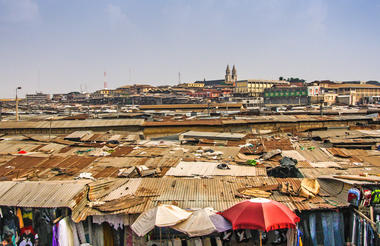
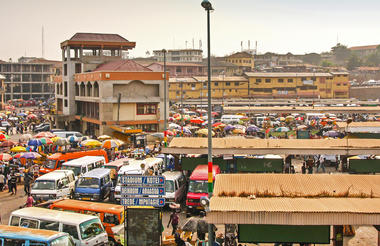
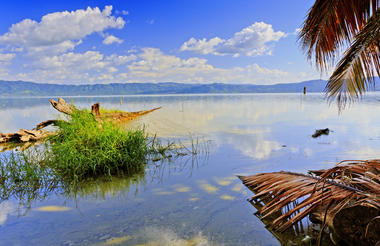
Ashanti Culture
In the morning continuation of the tour of Kumasi, with the visit to the Royal Palace Museum hosting a unique collection of gold jewels worn by the Ashanti court.
If the date coincides, the program will be modified to participate at the great event: Akwasidae Festival
In the afternoon visit to a few Ashanti villages with traditional clothing and carving.



Kumasi Royal Palace Museum
Ashanti Villages
Drive to the coast. The coast of Ghana (formerly known as Gold Coast) has more than 50 ancient forts and castles, reminiscent of the ancient gold, ivory and slave trade.
Cape Coast castle was built by the Swedish in 1653. From 1657 to 1664 it changed hands many times as it was conquered by the Danes, the Dutch, the Fanti (a local tribe), the Swedes and finally the British. Today, it hosts a museum on the history of slave trade.
In Cape Coast, we will also visit Fort William, hosting a lighthouse. From the top of the castle, you will enjoy a magnificent view of the town.
.Kumasi to Anomabu (250 km – travel time: 4 h)
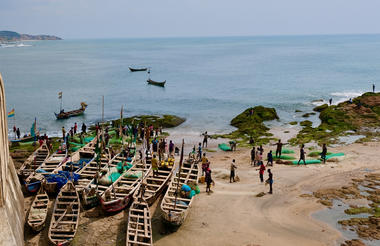
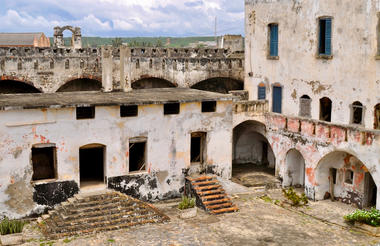
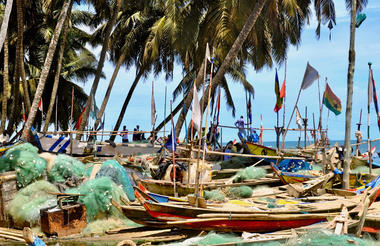
Cape Coast Slaves Castle
A few kilometres north of the coast, in the middle of a rainforest, we will discover the Kakum National Park. This park gives you a great opportunity to observe the forest from above as Kakum has a canopy walk hung high up in the trees. The Kakum canopy walkway is the longest and highest rope bridge in the world. Walking between 120 to 150 feet above the ground, you will enjoy an incredible view of the rain forest. At this height, instead of revealing their trunks, the trees offer a breath-taking view of their canopies and look as if they were trying to touch the sun and sky above.
Then we reach Elmina Castle, the oldest European building in Africa, erected by the Portuguese in the 15th century. At different times the castle has been used as a warehouse to trade gold, ivory, and eventually slaves. The castle we visit today is the result of successive extension works and is recognized as a UNESCO World Heritage site. The old Dutch Cemetery in Elmina goes back to 1806. Outside the castle, there is a spectacular fishing village with lots of large colourful fishing boats – every day these large wooden pirogues conducted by skilled fishermen across strong ocean waves and currents, “fighting” to earn a living. The alleys in the old town have a very lively atmosphere, bringing us back to a time when Elmina was a busy colonial town.
In a neighbour town we will discover the Posuban, shrines of the Asafo companies where the Asafo warriors still pour libations.



We head to Accra.
Accra, the capital of Ghana, has kept its unique identity despite the fast-paced development of the last decades with its modern buildings and large avenues. The luxuriant administrative area, punctuated with elegant villas built during the first half of the 19th century, reminds us that was the most flourishing colony in Africa.
We explore James Town historic neighbourhood, inhabited by Ga people. Facing the Ocean is where native people life, fully unfolds: a village surrounded by the city! Here all economic activities follow very different rules from the ones governing “the city” (business area), just a few hundred meters away. We continue with the visit of a workshop specialized in “fantasy coffins”. These unique handcrafted coffins can reflect any shape: fruits, animals, fish, cars, airplanes…. The only limit being imagination! Started in Accra, these flamboyant coffin designs are by now collected worldwide and exposed in museums.
In the evening transfer to the airport for the flight out.
Anomabu to Accra (180 km – travel time: 3 h)



